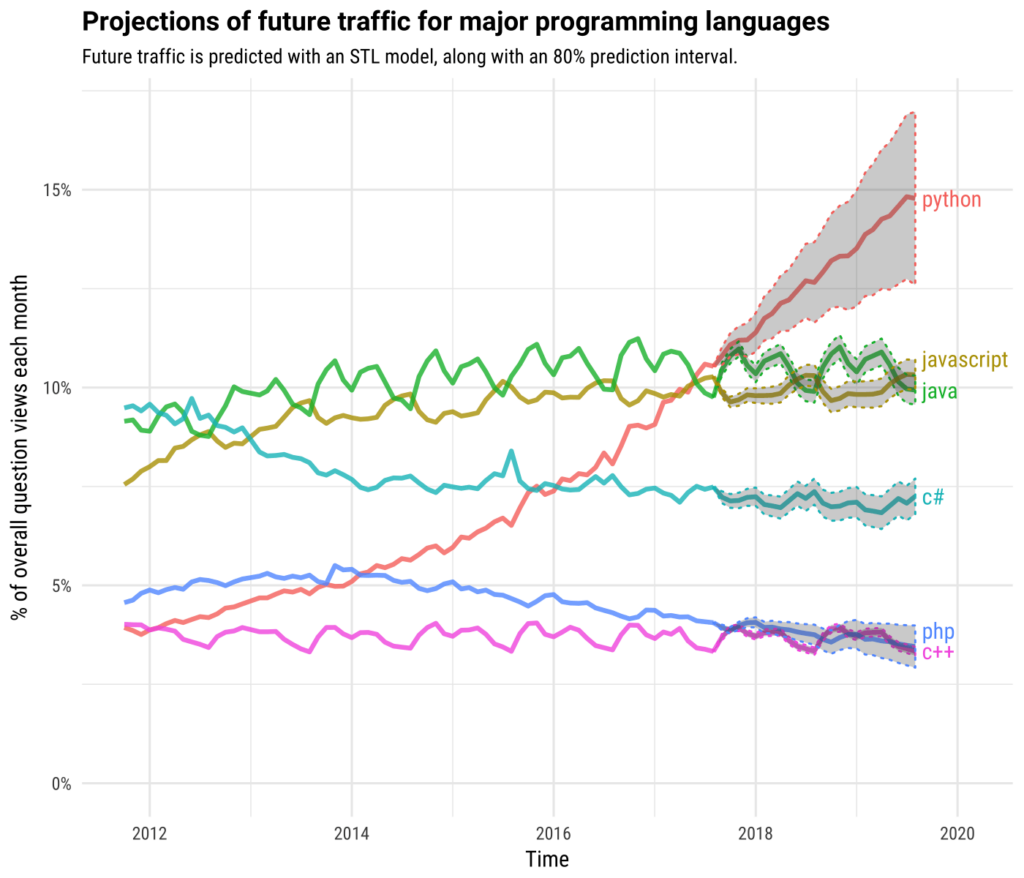In this blog, I will share the most wanted language which is used for developing machine learning algorithms. Why Python for machine learning algorithms?
Machine learning is a process of building AI (Artificial Intelligence) enabled algorithms in which machines can learn or produce codes automatically by analyzing the processed data. Machine learning is the division of Artificial Intelligence and again has the node with many fields including math and psychology.

But some people assume that Python is the most powerful language used for machine learning. Now after giving a brief introduction let’s start with the tech part of the article:
The Beginning
Back in 1991 when Guido van Rossum released Python as his side project, he didn’t expect that it would be the world’s fastest-growing programming language shortly. If we follow the tech trends, Python turns out as a goto language for fast prototyping and machine learning algorithms.
A statement from the StackOverflow developer survey in 2017
Why Python?
Python is a general-purpose language — sometimes referred to as utilitarian — that is designed to be simple to read and write. The point that it’s not a complex programming language is important.
That’s the only reason Python has become so popular — it’s an assembly-based language meant for enterprise and first-class projects, and it has a rich history. It can be used for anything, which is why it’s considered so versatile. You can build Raspberry Pi applications, scripts for desktop applications and servers configure everything via Python, but it’s not limited to just those tasks.
With Python, there are no limits.
Why Python for Machine Learning Algorithms?
Now let’s understand why anyone would want to use only Python in any Machine Learning project. Machine learning, in layman’s terms, is to use the data to make a machine-intelligent decision. For example — you can build a spam detection algorithm where the rules can be learned from the data or an anomaly detection of rare events by looking at historical data or arranging your email based on tags you had assigned by learning about email history and so on.
Machine learning is nothing but to recognize patterns in your data.
An important task of a Machine learning engineer in his/her work life is to extract, process, define, clean, arrange, and then understand the data to develop intelligent algorithms.
So for a Machine learning engineer like me or a budding Data Scientist/Machine Learning/Algorithm Engineer/Deep learning engineer why I would recommend Python because it’s easy to understand.
Sometimes the concepts of Linear Algebra and calculus are so complex; that they take a maximum amount of effort. A quick implementation in Python helps a Machine Learning engineer to validate an idea.
Data is the Key
So it depends on the task where you want to apply Machine learning. I work on tweet analysis projects. So the input data for me is the trending tweets. For someone else, it would be a series of points over time or a collection of trends across various domains or images given or just statuses.
Imagine everything that exists around you is data. And it’s raw, unstructured, bad, incomplete, and large. How Python can tackle all of them? Let’s see.
Packages, Packages Everywhere!
Yes, you guessed it right. It’s the collection and code stack of various open source repositories that is developed by people (still in process) to continuously improve upon the existing methods.
Want to work with images — numpy, opencv, scikit
Want to work in text — nltk, numpy, scikit
Want to work in audio — librosa
Want to solve machine learning problem — pandas, scikit
Want to see the data clearly — matplotlib, seaborn, scikit
Want to use deep learning — tensorflow, pytorch
Want to do scientific computing — scipy
Want to integrate web applications — Django
Want to take a shower …. Well
The best thing about using these packages is that they have zero learning curve. Once you have a basic understanding of Python, you can just implement it. They are free to use under GNU license. Just import the package and use it.
The best thing about using these packages is that they have zero learning curve. Once you have a basic understanding of Python, you can just implement it. They are free to use under GNU license. Just import the package and use it.

The End
Well, if we focus on the overall task that is needed to train, validate, and test the models — as far as it satisfies the aim of the problem, any language/tool/framework can be used. Be it in extracting raw data from an API, analyzing it, doing an in-depth visualization, and making the classifier for the given task.
But the main reason for using Python would be its readability, versatility, and easiness.
